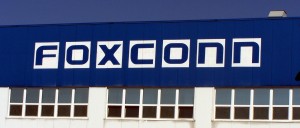 Hon Hai Precision Industry Co. (2354.TW) of Taipei, Taiwan, better known in some regions as Foxconn Technology Group, is the world’s largest electronics contract manufacturer and produces electronic components for the iPad, iPhone, Xbox One, PlayStation 4 and many other consumer technologies.
Hon Hai Precision Industry Co. (2354.TW) of Taipei, Taiwan, better known in some regions as Foxconn Technology Group, is the world’s largest electronics contract manufacturer and produces electronic components for the iPad, iPhone, Xbox One, PlayStation 4 and many other consumer technologies.
Foxconn is engaging in some research and development activities that are looking to strengthen the company in areas outside contract manufacturing for other corporations. Carbon nanotechnologies and Big Data solutions are the focus of R&D agreements signed in July of last year between Foxconn and both Tsinghua University and Peking University. To spur innovation from outside of the company, the company has launched a platform called Kick2real which provides no-cost prototyping for projects in wearable tech, mobile accessories and other categories. Future innovation from within Foxconn could result in some interesting automotive technologies; in June 2014, the company announced that it would work to develop electric vehicles which will sell for less than $15,000 USD. Back in April of 2014, Foxconn divested itself of some patents in head-mounted displays by selling them to Google, possibly setting up a greater working relationship between the two corporations.
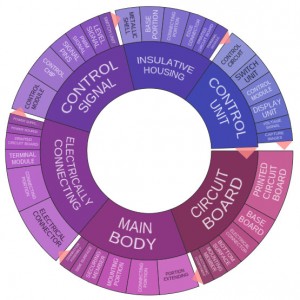 In 2014, Foxconn led all Taiwanese companies in terms of patents granted by the U.S. Patent and Trademark Office, despite earning around 700 fewer U.S. patent grants compared to the company’s 2013 totals (2,279 patents). 2014 saw Hon Hai Precision place 18th overall in U.S. patent grants, tied with Swedish communications developer Ericsson with 1,537 U.S. patents that year.
In 2014, Foxconn led all Taiwanese companies in terms of patents granted by the U.S. Patent and Trademark Office, despite earning around 700 fewer U.S. patent grants compared to the company’s 2013 totals (2,279 patents). 2014 saw Hon Hai Precision place 18th overall in U.S. patent grants, tied with Swedish communications developer Ericsson with 1,537 U.S. patents that year.
The text cluster diagram (shown right) created using Innography patent analytics tools provides a snapshot into Hon Hai’s 2014 U.S. patent grants. During 2014, Hon Hai was very active in protecting innovations generally related to circuit boards, especially printed circuit boards. Other areas of significant focus included control units, control signals and electronic connections.
Much of the world’s electronics contract manufacturing is based in Taiwan and Southeast Asia, a region over which Hon Hai Precision holds a commanding lead. In 2013, the company bested the sales of the region’s 2nd-place finisher Pegatron, which had nearly $35 billion USD in sales, almost three times over with sales that approached $140 billion USD. The company employees a massive number of workers wherever it operates and in June 2014 it was looking to hire 100,000 additional workers in China to meet iPhone 6 production demands. As of this writing, Hon Hai’s stock on the Taiwan Stock Exchange (TWSE) was trading at around 87 New Taiwan Dollars (TWD), or about $2.75 USD, per share, although the company also posted a one-year return of 16.18 percent stock growth.
What follows is a review of recently issued patents and recently published patent applications.
[Companies-1]
Foxconn’s Issued Patents: Nerve Grafts, Electronic Incense and a Wirelessly Charging Smart Watch
We were able to find a couple of patents which showcased Hon Hai Precision’s partnership with Tsinghua University in Beijing, China, focused on some intriguing areas of carbon nanotube technology. A laser-induced method for fabricating carbon nanotubes with improved morphology and other characteristics is disclosed and protected by U.S. Patent No. 8926934, which is titled Laser-Based Method for Growing an Array of Carbon Nanotubes. The method for growing an array of carbon nanotubes protected here involves forming a catalyst film of graphite onto a provided substrate, flowing a carrier gas/carbon source gas mixture in the open air over the substrate and focusing a laser beam on the catalyst film, heating the film to a predetermined temperature for forming carbon nanotubes. The open air method of this invention overcomes shortcomings associated with closed reactor carbon nanotube formation, 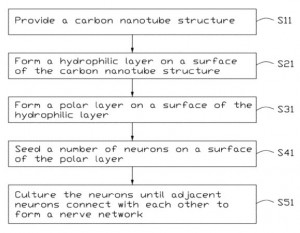 which results in an intense laser field that can damage the nanotubes. We were piqued to find a very interesting medical application for carbon nanotubes expressed within U.S. Patent No. 8900866, issued under the title Method for Forming Nerve Graft. The method for forming a nerve graft claimed here includes evaporating or sputtering an inorganic material onto the surface of a carbon nanotube structure to form a hydrophilic layer and soaking the carbon nanotube structure with the hydrophilic layer in either a polyamino acid solution or a polyetherimide solution to polarize a surface of the carbon nanotube structure. Neurons can be seeded and cultured on the polarized surface and grown into useful nerve grafts for reconnecting opposite terminals in broken neurites. Both of these above patents are jointly issued to Hon Hai Precision and Tsinghua University.
which results in an intense laser field that can damage the nanotubes. We were piqued to find a very interesting medical application for carbon nanotubes expressed within U.S. Patent No. 8900866, issued under the title Method for Forming Nerve Graft. The method for forming a nerve graft claimed here includes evaporating or sputtering an inorganic material onto the surface of a carbon nanotube structure to form a hydrophilic layer and soaking the carbon nanotube structure with the hydrophilic layer in either a polyamino acid solution or a polyetherimide solution to polarize a surface of the carbon nanotube structure. Neurons can be seeded and cultured on the polarized surface and grown into useful nerve grafts for reconnecting opposite terminals in broken neurites. Both of these above patents are jointly issued to Hon Hai Precision and Tsinghua University.
Lighting technologies were at the center of a few other patents we perused today. We got a look at one innovation from a smattering of automotive tech that we noted in Hon Hai’s recently issued patents. U.S. Patent No. 8915632, issued under the title Vehicle Headlamp System, claims a system comprised of an ultraviolet light emitting diode (LED), a phosphor layer and a first lens disposed between the ultraviolet diode and the phosphor layer that concentrates the ultraviolet light heading to the phosphor layer to obtain a white light. The LED system protected here creates a much lower environmental impact than conventional mercury, xenon or sodium lamps which utilize higher levels of electricity and releases pollutants into the environment when destroyed. Energy-efficient lighting solutions are also the major topic of discussion within U.S. Patent No. 8919987, entitled LED Display Unit With Solar Panels and LED Display Device Including the Same. The LED display unit protected by this patent contains a light guide with a first light incident surface connected to a light emitting surface, a diffusion layer with a second light incident surface adjacent to the light emitting surface, a first LED module adjacent to the first light incident surface a side surface solar panel connected to the LED module which collects sunlight scattered by the diffusion particles in the diffusion layer. The invention is intended to impact outdoor LED displays, especially advertising content, which do not utilize the solar energy irradiating onto the outdoor LED device.
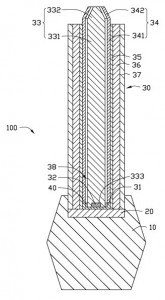 A few other interesting consumer electronics products highlighted the rest of the recent Foxconn patents that we were able to survey. An electronic censer for producing incense smells with reduced smoke and risk of fire is the focus of U.S. Patent No. 8911672, simply titled Electronic Censer. This electronic censer includes a hollow censer body containing a circuit board, an LED incense branch positioned on the circuit board that extends away from the censer body, multiple incense cores, one of which is made of light transmissive material,
A few other interesting consumer electronics products highlighted the rest of the recent Foxconn patents that we were able to survey. An electronic censer for producing incense smells with reduced smoke and risk of fire is the focus of U.S. Patent No. 8911672, simply titled Electronic Censer. This electronic censer includes a hollow censer body containing a circuit board, an LED incense branch positioned on the circuit board that extends away from the censer body, multiple incense cores, one of which is made of light transmissive material,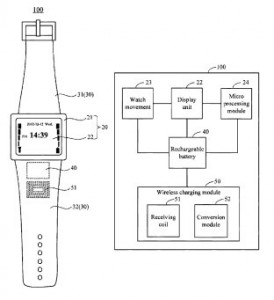 and a heat dissipating board that takes heat generated by the LED and uses it to heat a liquid fragrance to generate incense vapor. This censer does not require the lighting of aromatic materials with fire, which is used by traditional censers. Hon Hai Precision also has its own entry in the global parade of smart watches being developed in recent years through the issue of U.S. Patent No. 8908479, which is titled Electronic Wrist Watch Having Wireless Charging Function. The patent claims an electronic wrist watch with a wrist strap portion having two wrist straps, at least one rechargeable battery that supplies power to the wrist watch and a wireless charging module electrically connected to the rechargeable battery and configured to wirelessly collect external energy. This invention achieves a simplification to charging a smart watch without increasing the products size with wireless charging components.
and a heat dissipating board that takes heat generated by the LED and uses it to heat a liquid fragrance to generate incense vapor. This censer does not require the lighting of aromatic materials with fire, which is used by traditional censers. Hon Hai Precision also has its own entry in the global parade of smart watches being developed in recent years through the issue of U.S. Patent No. 8908479, which is titled Electronic Wrist Watch Having Wireless Charging Function. The patent claims an electronic wrist watch with a wrist strap portion having two wrist straps, at least one rechargeable battery that supplies power to the wrist watch and a wireless charging module electrically connected to the rechargeable battery and configured to wirelessly collect external energy. This invention achieves a simplification to charging a smart watch without increasing the products size with wireless charging components.
Patent Applications of Note: From Wirelessly Charging Steering Wheels to Smart Home Networks
 While looking through the patent applications most recently filed by Hon Hai Precision with the USPTO, we noticed a stronger assortment of vehicular technologies that had been developed by that corporation. A steering wheel with a wireless charging system that could be utilized with the electronic wrist watch described above is the center of U.S. Patent Application No. 20140375259, which is titled Steering Wheel and Car Using the Steering Wheel. The patent application would protect a steering wheel configured to charge an electronic device having a receiving module. The steering wheel is comprised of a rim, an emitting module with an emitting coil coupled to an electrical power source configured to convert alternating current (AC) power into electromagnetic waves of specific frequencies for emission towards a receiving module. This system would support the charging of rechargeable batteries in a wrist watch device without requiring a driver to remove the watch while driving. In-vehicle charging systems for an array of electronic devices, including mobile phones, are the focus of U.S. Patent Application No. 20150008881, filed under the title Vehicle Charger. The vehicle charger claimed here includes a plug portion extending away from a main body which can be electrically coupled to a power supply, an electricity transmission portion formed on the main body for coupling with electronic devices, a circuit unit for detecting power supply modules and charging circuits, a microprocessor and a display screen. A user would plug the plug portion into a car’s cigarette lighter to charge an electronic device while viewing charging circuit information on the display screen provided. A more cost-effective design for vehicle headlamps is featured within U.S. Patent Application No. 20150029409, which is titled Vehicle Lamp With Liquid Crystal Layer. The vehicle lamp protected here includes a light source emitting light, a diffracting element that diffracts the light to form a pattern and a liquid crystal layer which is switchable between multiple states which support light transmittable areas of different sizes. The liquid crystal layer achieves the effect of switching between low beam and high beam without requiring a movable mechanism that often inhabits a large volume of headlamp space.
While looking through the patent applications most recently filed by Hon Hai Precision with the USPTO, we noticed a stronger assortment of vehicular technologies that had been developed by that corporation. A steering wheel with a wireless charging system that could be utilized with the electronic wrist watch described above is the center of U.S. Patent Application No. 20140375259, which is titled Steering Wheel and Car Using the Steering Wheel. The patent application would protect a steering wheel configured to charge an electronic device having a receiving module. The steering wheel is comprised of a rim, an emitting module with an emitting coil coupled to an electrical power source configured to convert alternating current (AC) power into electromagnetic waves of specific frequencies for emission towards a receiving module. This system would support the charging of rechargeable batteries in a wrist watch device without requiring a driver to remove the watch while driving. In-vehicle charging systems for an array of electronic devices, including mobile phones, are the focus of U.S. Patent Application No. 20150008881, filed under the title Vehicle Charger. The vehicle charger claimed here includes a plug portion extending away from a main body which can be electrically coupled to a power supply, an electricity transmission portion formed on the main body for coupling with electronic devices, a circuit unit for detecting power supply modules and charging circuits, a microprocessor and a display screen. A user would plug the plug portion into a car’s cigarette lighter to charge an electronic device while viewing charging circuit information on the display screen provided. A more cost-effective design for vehicle headlamps is featured within U.S. Patent Application No. 20150029409, which is titled Vehicle Lamp With Liquid Crystal Layer. The vehicle lamp protected here includes a light source emitting light, a diffracting element that diffracts the light to form a pattern and a liquid crystal layer which is switchable between multiple states which support light transmittable areas of different sizes. The liquid crystal layer achieves the effect of switching between low beam and high beam without requiring a movable mechanism that often inhabits a large volume of headlamp space.
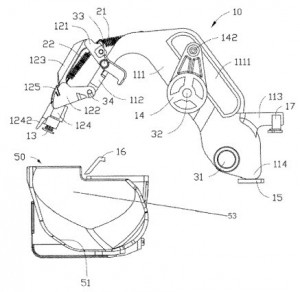 Foxconn’s patent applications detail even more intriguing electronics products developed for specific sectors of consumers, especially those with healthcare needs. A device that increases the ease of taking medications among the chronically ill and elderly is described within U.S. Patent Application No. 20150028048, which is titled Automatic Pill Grasping Apparatus. The patent application would protect an automatic pill grasping apparatus having a base, a control chip, a pill grasping mechanism with a grasping arm, driving mechanism and nozzle, and a pill storage mechanism having both a plurality of cases for storing pills and an actuation mechanism. The system is designed so that a pill can be released from a storage case to a pill output case so that the pill grasping mechanism can draw the pill towards a patient through the use of a vacuum force provided by the nozzle. An eyewear innovation that provides an energy-efficient tool for protecting eyesight is discussed within U.S. Patent Application No. 20150022776, filed under the title Photochromic Spectacles. The photochromic spectacles claimed here include two lenses
Foxconn’s patent applications detail even more intriguing electronics products developed for specific sectors of consumers, especially those with healthcare needs. A device that increases the ease of taking medications among the chronically ill and elderly is described within U.S. Patent Application No. 20150028048, which is titled Automatic Pill Grasping Apparatus. The patent application would protect an automatic pill grasping apparatus having a base, a control chip, a pill grasping mechanism with a grasping arm, driving mechanism and nozzle, and a pill storage mechanism having both a plurality of cases for storing pills and an actuation mechanism. The system is designed so that a pill can be released from a storage case to a pill output case so that the pill grasping mechanism can draw the pill towards a patient through the use of a vacuum force provided by the nozzle. An eyewear innovation that provides an energy-efficient tool for protecting eyesight is discussed within U.S. Patent Application No. 20150022776, filed under the title Photochromic Spectacles. The photochromic spectacles claimed here include two lenses 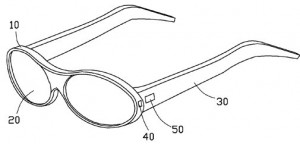 arranged in a frame, both of which are comprised of a substrate, an electrochromic film and a transparent solar cell film that absorbs both infrared and ultraviolet light and converting it into power for the use of a driving circuit connected to the electrochromic film. This innovation results in a pair of photochromic spectacles, which utilize energized elements to protect a wearer’s eyes from unwanted external light stimulation while slimming the size of the spectacles from bulkier battery-powered versions.
arranged in a frame, both of which are comprised of a substrate, an electrochromic film and a transparent solar cell film that absorbs both infrared and ultraviolet light and converting it into power for the use of a driving circuit connected to the electrochromic film. This innovation results in a pair of photochromic spectacles, which utilize energized elements to protect a wearer’s eyes from unwanted external light stimulation while slimming the size of the spectacles from bulkier battery-powered versions.
We took note of an intriguing system for firefighting developed by Foxconn that was among its recently filed patent applications. U.S. Patent Application No. 20150002290, entitled Fire Control System and Method, claims a fire control method executed by the processor of an electronic device in wireless communication with a fire alarm controller. The method involves requesting status information of a fire alarm controller, displaying status information on the electronic device’s display screen and transmitting an operation command from the device to the fire alarm controller to control fire equipment electrically connected to the fire alarm controller. This allows managers of firefighting teams to conveniently monitor the status of fire equipment and quickly adjust operation to extinguish a blaze.
We don’t typically feature patents which are jointly assigned to the Companies We Follow, but Foxconn supports a large amount of cooperative innovation and we were piqued by the Internet of Things technology outlined within U.S. Patent Application No. 20140369231, titled Smart Home Network System and Method for Registering Home Devices. This patent application is jointly assigned to Foxconn and Hong Fu Jin Precision Industry Co. of Shenzhen, China. The smart home network system comprised of a plurality of devices claimed here includes a register controller and a smart gateway which has a first storage module storing a mapping list, a first communication module receiving configuration information from the home devices and a first control module configured to register configuration information of home devices in a corresponding region on a mapping list. The register controller also includes several modules for processing a registration command with respect to a smart gateway. This invention is intended to simplify the process of adding a new device to a smart home network.

![[IPWatchdog Logo]](https://ipwatchdog.com/wp-content/themes/IPWatchdog%20-%202023/assets/images/temp/logo-small@2x.png)

![[Advertisement]](https://ipwatchdog.com/wp-content/uploads/2024/04/Patent-Litigation-Masters-2024-sidebar-early-bird-ends-Apr-21-last-chance-700x500-1.jpg)

![[Advertisement]](https://ipwatchdog.com/wp-content/uploads/2021/12/WEBINAR-336-x-280-px.png)
![[Advertisement]](https://ipwatchdog.com/wp-content/uploads/2021/12/2021-Patent-Practice-on-Demand-recorded-Feb-2021-336-x-280.jpg)
![[Advertisement]](https://ipwatchdog.com/wp-content/uploads/2021/12/Ad-4-The-Invent-Patent-System™.png)







Join the Discussion
No comments yet.